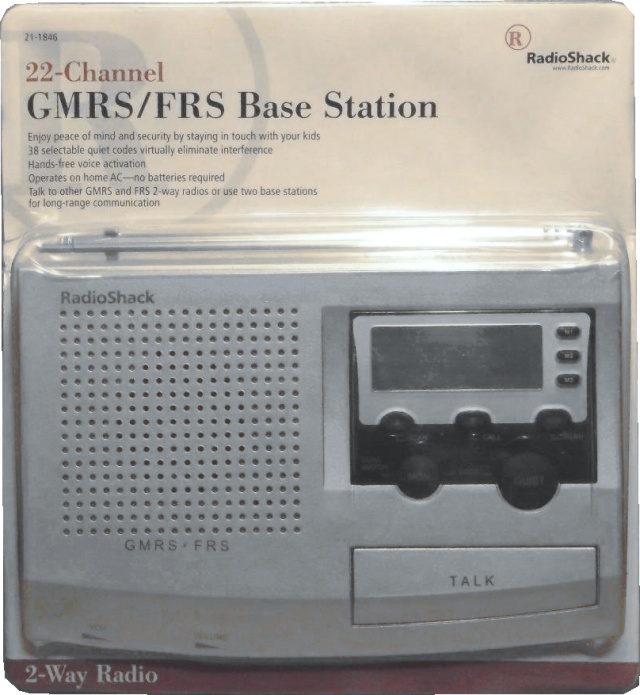RadioShack 22 Channel GMRS FRS Base Station 21-1846
Radio Shack model 21-1846 22-Channel GMRS/FRS Base Station.
This is a type of wireless intercom, however, unlike previous Radio Shack wireless intercoms, this uses an over-the-air Ariel transmitting antenna rather than placing RF directly into your home electrical system.
210-1846 GMRS/FRS Intercom Base Station 2-Way Personal Radio
Features:
- 38 selectable quiet codesvirtually eliminate interference
- Hands-free voice activaition
- Operates on home AC-no batteries required
- Talk To Other GMRS and FRS 2-way radios
This is an A/C powered wireless intercom using FRS/GMRS radio frequencies.
- AD DC Adapter - [Transformer]
Review
Over the years the many models of Radio Shack intercoms varied in quality and reliability. The use of CTCSS tone encoded squelch helps to overcome some of the issues with FRS congestion in urban settings. It should be mentioned that although CTCSS is sometimes referred to as privacy codes this provides absolutely no privacy against eavesdropping on external FRS receivers, it is simply a way to reduce or eliminate unwanted radio interference from nearby transmissions. Radio Shack introduced three channel memories for this model. This gave the advantage that you could set up different rooms on one of the three channels so that more specific room by room paging is possible. This might be more useful in a small office rather than home use where a whole family "it's dinner time" page is likely to be desirable.
Channel and CTCSS tone were set by using the push buttons on the top of the unit. Buttons could be short pressed, long pressed, or used in combination to achieve different functionality. However, the button system could be confusing and some of the terminology Radio Shack used didn't help to clarify. The CTCSS tone encoded squelch was toggled by a button that was rather large and labeled "Quiet" which is neither accurate nor convenient. Typically you either want to utilize tone encoded squelch all of the time, or you do not wish to use it. The large button was easy to bump which could lead to missing a page or receiving unwanted traffic. It was difficult to get the unit to lock so that frequency could not be accidentally changed.
The model FRS Base Station 21-1845 was easier to use after it was initially set up with the desired tone and frequency as it was less likely to be accidentally tuned off channel. However the newer model 21-1846 has the ability to operate on three memorized channel and tone pairs that could be matched with other units for specific room or office paging. Overall the simplicity or the older 21-1845 seems more desirable in most situations and thus the upgraded 21-1846 just has too many buttons and button combinations to be as simple to maintain once deployed. Both models operate within the FRS spectrum which can be overcrowded depending on where you live, but not so bad as you might think. Even though considered outdated and not operating on optimal frequencies, both the models 21-1845 and 21-1846 hold their own by today's standards and are light-years ahead in quality as compared to the terrible Chinese made Wuloo / Qniglo FRS Intercoms and other abomination intercom clones on the market today.
use
Using Vox
VOX allows you to transmit hands free. To activate VOX press the [VOX] button. This toggles between VOX on or off.
A quirk with this model is that although a short-press of the [VOX] button will enable VOX, it will not always disable it. A long-press of the [VOX] button activates the feature menu. To disable VOX you have to press the [VOX] button a bit longer than the short press that activates VOX, and not quite as long as it takes to de-activate VOX. Again, this is a glitch in some models.
